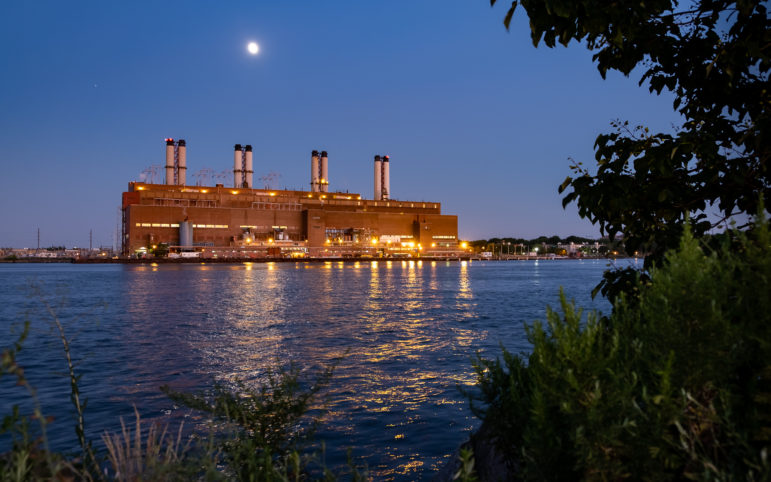‘Maintaining this expensive and dirty power grid is by no means a necessity—it is an ongoing policy choice.’

Adi Talwar
The ConEdison Power Plant Site in Astoria.Most of our neighbors have received painfully high electricity bills this winter from ConEd. For the millions of New Yorkers facing steep rent increases and rising prices for food and other necessities, this is an especially hard blow, and is likely to get worse this month.
The reason bills have shot up is because during peak demand hours, electricity prices have almost tripled. As ConEd explains, the problem is the rapidly rising cost of acquiring energy on the wholesale market that the utility then passes on to customers. Natural gas prices have indeed been spiking worldwide, driven partly by heating demand during the coldest winter months. Prices for both oil and natural gas are now being further exacerbated as energy markets react to the Russian invasion of Ukraine.
But there’s much more to this story in New York City that the big energy corporations and their backers in Congress aren’t telling us. Our electric grid is especially vulnerable to price shocks because 70 percent of our electricity is generated by power plants that burn fossil fuels—a sharp contrast to nearby regions that use more renewables like wind, solar and hydroelectric power. These fossil fuel plants are particularly susceptible to demand-driven price spikes, and even worse, the emissions released by these gas-burning power plants are particularly unhealthy for nearby residents, often people of color and low-income communities.
In New York City, many of these polluting power plants function as “peakers,” which power up on hot summer or cold winter days when residential and commercial buildings turn on cooling or heating devices.
This is an expensive, unjust and increasingly unnecessary way to keep our electrical grid running. ConEd payments to peaker plant owners are up to 1300 percent costlier than average New York State prices. And this inefficiency adds up. Over the past 10 years, utility payments to New York City peaker plant owners have totaled a whopping $4.9 billion just to keep the plants online and at the ready. Keeping these expensive and inefficient generators operational is one of the major costs directly passed on to consumers in the form of high monthly bills.
 CityViews are readers’ opinions, not those of City Limits. Add your voice today!
CityViews are readers’ opinions, not those of City Limits. Add your voice today!
Maintaining this expensive and dirty power grid is by no means a necessity—it is an ongoing policy choice. As the performance of technologies like rooftop solar panels, offshore wind projects and large-scale batteries has improved rapidly, their costs have also declined significantly. It is now both technologically feasible and economically wise to retire and replace NYC’s fleet of 19 fossil fuel-burning peakers with a mix of emissions-free alternatives and storage solutions. In addition to sharply reducing greenhouse gas and co-pollutant emissions, these renewables are the best strategy to protect customers from increasing fossil fuel prices by stabilizing generation costs.
We were thrilled that the state’s Department of Environmental Conservation recently denied NRG Corporation’s application to build more gas turbines at their plant in Astoria, Queens, as well as when private equity giant ArcLight withdrew a similar project in Sunset Park.
Government can play a critical role in accelerating the full-scale retirement of peakers and to ensure that they’re replaced with truly renewable and reliable energy sources.
That’s why we’re sponsoring and supporting the Pollution Justice Act of 2021, which would require peaker plant owners statewide to submit and adhere to a plan to retire and replace their facilities over the next decade as a condition of state permits. And that’s why some of NYC’s Congressional representatives have introduced the Justice in Power Plant Permitting Act, which would create a nationwide database of fossil fuel peakers and appropriate $10 billion toward replacing these plants with sustainable solutions.
Modernizing NYC’s outdated and inefficient energy grid is not a simple task, and it will require earnest investment and focus from stakeholders at all levels of government. Doing so will also require a new business approach, and a far more transparent and democratic approach to partnering with local communities from the corporations that have been operating and profiting from old and polluting power plants.
While major renewable and transmission projects are now poised to create both clean, affordable energy and good jobs in environmental justice communities like Sunset Park, we’ll also need more battery storage and transmission line improvements to make sure that renewable energy can find its way into our homes and businesses when it’s needed most. We’ll also need a six-fold expansion in renewable solar energy generated in and near the city—which means using a lot more rooftop space for solar panels, and putting our government to work to make sure that every possible public and private building can take advantage of solar energy and storage technology at an affordable and predictable price.
Utility customers for too long have been forced to spend billions supporting antiquated fossil fuel plants while being harmed by their pollution. Working and low-income families struggling to pay energy bills deserve immediate economic relief, and every New Yorker deserves a government that makes the bold investments needed now to protect us from the arrival of more utility bills far too many are hard-pressed to pay.
Elizabeth Yeampierre is the Executive Director at UPROSE. Justin Wood is the Director of Policy at New York Lawyers for the Public Interest. Daniel Chu is the Energy Planner at NYC Environmental Justice Alliance.








